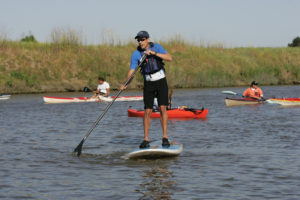There are so many choices in canoe paddles today, it is very difficult to select the one best suited for your individual needs. But you do need someplace to start. So, here are some characteristics for you to consider when picking out some paddles you would like to try out in actual use on the water:
Paddle Length
This is undoubtedly the most important specification you need to determine. The wrong length paddle on an extended cruise-even on calm water-can ruin your whole trip. Your muscles will rebel until your whole body is wracked in pain. So spend some time to get this one right. Unfortunately, there are several controversial methods (none of them perfect) for getting the measurement for each individual. Here are the most common ones:
Stand up straight and measure from the floor to your chin for bow paddle, and to your eyes for a stern paddle.
Sit in a chair and measure from the chair seat to your eyebrow and add that measurement to the blade length.
Sit in your canoe and measure from the water to your nose and add that measurement to the blade length of your preferred design.
I think you can see the fallacy in most of these methods (and your shoulders will pay the price). The best way to determine the proper paddle length for you is to take several paddles of the approximately correct length out on a trip and use them enough to know which length is ideal for you. On the other hand, if you are only going to paddle around on the lake in front of your summer cabin, any of the above systems will work fine for you.
Material
Paddles are made of many different materials today, but the most popular ones are made of wood, aluminum, or composite carbon fiber. Wood is still the most with canoeists, while aluminum and composite carbon fiber is popular with kayakers.
Aluminum is the lightest, and least expensive, paddle, but it can transmit cold from the water to your hands, forcing you to sometimes wear gloves. And, paddles made of aluminum are hardly aesthetically pleasing.
Composite Carbon Fibers make the strongest paddles, and their lightness give them the best strength-to-weight ratio. Although this material is easier on your muscles, it is not so easy on your wallet, and the aesthetics obviously cannot compare to certain woods. This is a popular paddle with kayakers, however.
Wood has long been the standard for canoe paddles, because it flexes slightly in the water and absorbs some of the shock, Wood does not transmit cold, and it has a better “feel” of the water. Needless to say, wood paddles can be downright beautiful. The only disadvantage is that some wood species can be fairly heavy, so be cautious when picking out a wood canoe paddle.
Bent Shaft vs. Straight Shaft
Bent shaft paddles have been around for a while and have become more popular in recent years, but there are many pros and cons about this feature. The decision is yours, but frankly, there is very little noticeable difference for the average recreational paddler.
Grips
The two basic grips on canoe paddles are the “T” grip and the “palm” grip. There are variations on each of these designs and the choice is yours, but much depends on your use. The “T” grip is usually preferred in whitewater because it gives a more positive grip for turning the paddle quickly while maneuvering. If you are in serious whitewater you do not want your hand to slip off the grip.
Blade Shape
A wooden paddle can have a blade of any shape, but the most popular are either oval or square-end. Traditional design calls for an asymmetrical oval blade, but if you are going to paddle often on small streams with gravel bottoms, you may want to consider a square-end paddle. You can also attach a metal guard on the bottom edge to stop excessive abrasion.
After you have done your research and shopping, you should make the final determination by trying out several paddles you think are right. You may have to borrow paddles from your friends and fellow paddlers to try out, but effort will be well worth it…and your body will thank you at the end of a long-day’s paddling.
Happy canoeing!
 Paddle Weekend Your Paddle Weekend
Paddle Weekend Your Paddle Weekend
